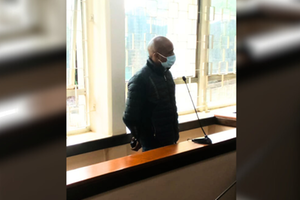‘Infrastructure Race’ good for us

The Sh60 billion Nairobi Expressway which is under construction.
What you need to know:
- Those who can pay tolls will be allowed to drive on those gleaming new highways.
- Drivers with a high value of time will be enjoying from reduced journey times even as the rest are left to suffer the consequences of congestion and clogged roads.
Welcome to the world of pay-as-you-drive highways — where toll superhighways run alongside motorways.
It will not be long before we see good and very well-maintained roads for the rich and poorly maintained roads for the poor. Those who can pay tolls will be allowed to drive on those gleaming new highways as they speed past their counterparts who are unable to afford toll charges.
Drivers with a high value of time will be enjoying from reduced journey times even as the rest are left to suffer the consequences of congestion and clogged roads.
Already, the first of such roads, the Sh60 billion Nairobi Expressway, is under construction. As we all know, this toll highway will be run and managed by the Chinese construction company, China Road and Bridge Corporation under a public-private partnership (PPP) arrangement.
The Chinese will build the road with their own money and then own and manage the highway for 20 years. They will hand over the highway to the government after recouping their investment.
But the biggest pay-and-drive deal in the pipeline is the one whose signing was witnessed by President Uhuru Kenyatta during his recent visit to France.
Pay-as-you-drive highway
At a ceremony in Paris, the President witnessed the signing of a commercial contract with the French construction conglomerate Vinci Highways to build for us the largest pay-as-you-drive highway between Nakuru and Nairobi.
Estimated to have a capital outlay of Sh160 billion, this is touted to be the largest PPP road concession in Africa.
Negotiated under the so-called PPP arrangement, it means that the French company will build the road with its own finances, take ownership control of the highway, charge users toll fees to recover its investment and, finally, revert ownership to the State after 30 years.
I don’t believe in privatisation of roads, ports, airports and large infrastructure, whether it is baptised as a PPP or a concession. This form of privatisation is the height of responsibility aversion by the State with endless controversies about pricing of tolls. Yet I find the Nairobi-Naivasha road project a possible game changer.
First is its scope. The current two-lane highway is to be expanded into a four-lane dual carriageway that will be expanded further into six lanes at busy sections.
Dealing with congestion
The scope of the construction will include widening of the road construction, building a four-kilometre viaduct through Nakuru Town and building multiple interchanges along the 233km highway.
The second reason is that it is, by far, the most ambitious attempt at dealing with congestion on this key and critical part of the Northern Corridor.
Kenha statistics show this section of the road carries an estimated 20,000 vehicles a day and vehicle traffic has been increasing at an annual rate of four per cent.
The third reason is the economic argument. You see, the most important economic and transport corridor for us is the Northern Corridor, which originates in Mombasa and terminates in Malaba.
I see a trend where — as countries in the region continue to shadow-box and plot to outwit one another over economic dominance and geostrategic significance — what is going to make a difference is the amount and level investment that a country commits on infrastructure and supply chains that connect it to its neighbours.
Just the other day, we were dismissing the Nairobi-Naivasha SGR section as a “railway to nowhere” and dismissing the inland container terminal as ill-conceived. But today, we are surprised to see that the volume of traffic consigned to the facility is growing and that, literally, all neighbouring countries are lining up to be accommodated there.
Contrary to popular opinion, Naivasha is good for Mombasa because it will be a boost to the coastal city’s accessibility to the hinterland.
We struggle to get a good economic justification for Kenya Pipeline Company’s Oil Jetty project in Kisumu because of short- termism thinking.
Let’s face it: Our neighbours are permanently engaged in a cloak-and-dagger game with us over economic dominance. The Ugandans decided to route their oil pipeline through Tanzania. Months later, we saw Kigali opting for a rail link through Dar es Salaam instead of Mombasa.
The point here is, in the context of the battle for economic dominance with our neighbours, the Nairobi-Nakuru PPP road project makes a great deal of sense. Had we developed this road earlier, the Northern Corridor would possibly have been the attractive route for Kigali.
We must fight to dominate in building roads on the major transport corridors, seaports, waterway links and networks of inland container terminals.





